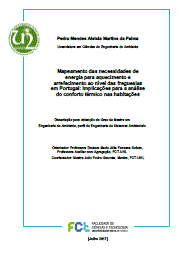
Mapeamento das necessidades de energia para aquecimento e arrefecimento ao nível das freguesias em Portugal: implicações para a análise do conforto térmico nas habitações [Mapping space heating and cooling energy needs at the parish level in Portugal: Implications for thermal comfort in the dwellings] [2017]

European Union has steered its policy towards the reduction of final energy consumption and the increase of energy efficiency. Accounting for a significant part of this consumption, the building sector has been a primordial target of this policies, particularly space heating and cooling. These two end uses are of utmost importance for health and well-being of people, therefore the goal of decreasing the energy consumption should not put at risk the access to thermal comfort in residential buildings. In Portugal, an old building stock with low energy performance, inexistent or low-efficiency climatization systems, and a considerable level of energy poverty are factors that may be preventing the achievement of adequate thermal comfort conditions in dwellings.
This study aims to assess the state of thermal comfort in residential dwellings, of all Portuguese civil parishes, according to the most recent administrative organization of the territory and the Residential Buildings Energy Performance Regulation (REH). A bottom-up buildings’ typology approach, supported on a set of key building’s characteristics (e.g. area, type of walls, bearing structure), was used to estimate the heating and cooling energy needs for thermal comfort. The distinct building characteristics of each region were taken into account in the typologies. A top-down energy use statistics-based approach was also used to estimate the heating and cooling final energy consumption for each of the civil parishes. The gap between these two indicators was used to assess the level of energy needs satisfaction, for standard thermal comfort conditions. Two sensitivity analysis scenarios based on adjustments concerning the typologies’ average conditioned areas and the climatization hours related to different occupancy schedules were tested. Results were mapped using the QGIS software for visualization and spatial analysis.
In the reference scenario, in which 100% of the households’ area and 24-hour climatization is considered, every civil parish had an energy gap higher than 60%, for both heating and cooling. The country’s global gap corresponded to respectively 92% and 96%. In the alternative scenarios, where a reduction of the heated/cooled area and the climatization period were evaluated, the gap of a considerable number of civil parishes was bridged. Because of its higher gaps, the civil parishes located in the Beiras e Serra da Estrela and Terras de Trás-os-Montes regions were identified as the most vulnerable in the winter, whilst the civil parishes in Beira Baixa are the most vulnerable in the summer season.
In this study, a high-resolution spatial scale assessment of thermal comfort levels during the heating and cooling seasons in Portugal was performed. For lower requirements than those of the REH, the following situations occurred: a) civil parishes’ energy performance gap eliminated, deriving from specific temporal-space climatization patterns, without compromising thermal comfort conditions; b) High gap uphold, stemming from significant energy poverty levels.
Full publication here.